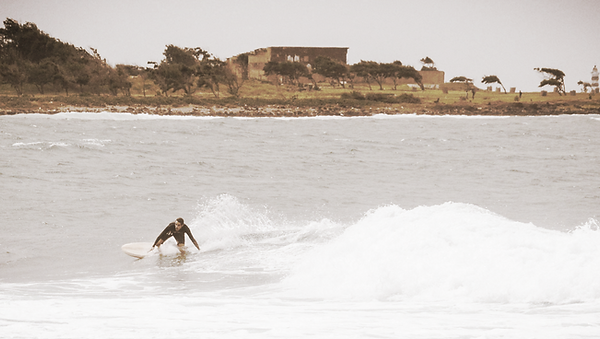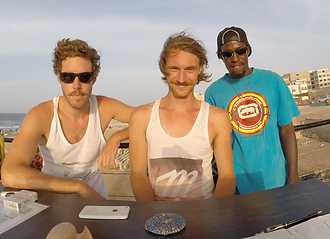Wooden Boards with Soul
Dario Zadra and Leandro Destefani make some rad wooden surfboards in Dakar. And now they’re teaching local menuisiers (carpenters in French) how to build these boards themselves. Hopefully this starts a wooden surfboard movement (author’s hopes) coming out of Dakar. We sat down with Dario, Leandro, and Happy, the new shaper on the team to discuss their project and the birth of these stylish wooden magic carpets.

How long have you guys been shaping the wooden boards and how did you decide on the materials and styles?
D: It’s been a year and a half, now, and it all started from a bachelor’s thesis in product design. We wanted to make boards, but we wanted to try doing it in a new surrounding with materials we’re unfamiliar with. Kind of for the challenge; or maybe it was out of laziness...
L: We wanted to practice product design by using what’s here. We actually decided on the wooden boards because that’s one of the most abundant materials used here.
And how did you pick Dakar?
L: We wanted to pick somewhere far away, but some place with some connection.
D: Yeah, we had to know the place somewhat. I came here to surf six years ago and I got to know some people and the environment which was necessary for the project.
And so now that the thesis is complete, what’s Menuisier’s project now?
D: We want to continue making the wooden boards, ones that are affordable and surfable. And definitely to improve the designs as well; we’re hoping they get lighter!
L: We want to try different kinds of wood as well and improve the performance and weight as we expand and have local menuisiers continue the work. We’re planning on handing it off and are working to help it run itself right now.
D: But we’ll always be a part of it, cus’ you know, we created it.
How did you get shaping, anyways? Do you have experience shaping with foam?
D: No, just standing on them. Haha, it was all trial and error until we got a working prototype.
L: And and prototyping was so difficult finding the right wood and shape and then learning to shape and glue took time. What happens after with warping is something we’re still learning about too because everything is still moving after it’s put together.

How did you get shaping, anyways? Do you have experience shaping with foam?
D: No, just standing on them. Haha, it was all trial and error until we got a working prototype.
L: And and prototyping was so difficult finding the right wood and shape and then learning to shape and glue took time. What happens after with warping is something we’re still learning about too because everything is still moving after it’s put together.

That all makes sense. And what about you Happy, has it been difficult moving from your work of traditional carpentry to board shaping?
H: Not too much; it’s not like foam or epoxy where the smallest mistake just ruins the board. It’s easier to fix mistakes with the wood. But you can’t make too many mistakes or it won’t work, and the material is expensive; you don’t want to waste anything.
Do you think the construction of these wooden boards will catch on with other menuisiers in Dakar?
H: People have a priority to building, so I hope other menuisiers will be
making them. But it’s very difficult to copy the design and steps. So just to try and learn will be high risk. But people will try.
Hopefully young guys will grow with the boards, but with kids wanting high performance boards these days, we’ll see.
And so what’s the plan for Menuisier?
D: To get bigger than Bantu [smiles maliciously; laughs ensue]. No, we would like to keep improving the boards and maybe expand, ‘cus that’s always a goal. But we need to improve the designs and learn much more first.
L: It would be cool to be making these with all kinds of different woods and shapes, so that’s what we’re working on now.
This discussion took place on Nov 28, 2015. For more reach out to the guys at contact@menuisier-surfboards.com
